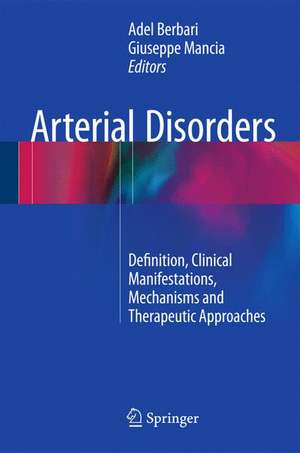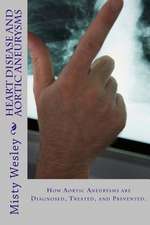Arterial Disorders: Definition, Clinical Manifestations, Mechanisms and Therapeutic Approaches
Editat de Adel Berbari, Giuseppe Manciaen Limba Engleză Hardback – 31 mar 2015
Preț: 730.92 lei
Preț vechi: 769.39 lei
-5% Nou
Puncte Express: 1096
Preț estimativ în valută:
139.86€ • 145.74$ • 115.80£
139.86€ • 145.74$ • 115.80£
Carte tipărită la comandă
Livrare economică 03-17 aprilie
Preluare comenzi: 021 569.72.76
Specificații
ISBN-13: 9783319145556
ISBN-10: 331914555X
Pagini: 500
Ilustrații: IX, 431 p. 61 illus., 41 illus. in color.
Dimensiuni: 155 x 235 x 25 mm
Greutate: 0.79 kg
Ediția:2015
Editura: Springer International Publishing
Colecția Springer
Locul publicării:Cham, Switzerland
ISBN-10: 331914555X
Pagini: 500
Ilustrații: IX, 431 p. 61 illus., 41 illus. in color.
Dimensiuni: 155 x 235 x 25 mm
Greutate: 0.79 kg
Ediția:2015
Editura: Springer International Publishing
Colecția Springer
Locul publicării:Cham, Switzerland
Public țintă
Professional/practitionerCuprins
PART I Introduction: Definition/Epidemiology of arterial disease.- PART II Normal structure and physiology of the arterial system.- PART III Classification of arterial pathology and clinical manifestations: Atherosclerosis.- Arteriosclerosis.- Disease of Precapillary resistance vessels.- PART IV Pathogenetic mechanisms in arterial disease: Hemodynamic and mechanical factors.- Metabolic factors.- Inflammatory markers.- Neurohormonal interactions.- Mineral-bone/ arterial interactions.- Endothelial function and impairment.- Miscellaneous: Pharmacologic/factors/environmental factors.- PART V Systemic arterial disorders: Arterial aging.- Diabetes mellitus.- Metabolic Syndrome/obesity.- Chronic kidney disease/Renovascular interactions.- Pulmonary Hypertension/Pulmonary vascular interactions.- Systemic vasculitides.- Genetic/ degenerative disorders.- Hypertension.- Toxemia of pregnancy.- Kidney transplants, both donors and recipients.- PART VI Evaluation procedures: Arterial function.- Renal resistive index.- Retinal microcirculation.- PART VII Therapeutic options: Lifestyle modifications.- Pharmacologic approaches.
Recenzii
“This book defines and examines the pathophysiological mechanisms of arterial disorders. … Although intended primarily for general physicians, basic scientists, and physiologists who manage cardiovascular disorders, the book is also useful for internists and medical trainees. … The book includes a comprehensive reference list, color pictures, diagrams, and tables.” (Dustin Y. Yoon, Doody's Book Reviews, May, 2015)
Textul de pe ultima copertă
As our knowledge about arterial disease is greatly expanding, the aim of this book is to explore all aspects of arterial pathology, including classification, clinical manifestations, pathogenesis, and therapeutic options. The discussion of pathophysiologic mechanisms of arterial disease is wide ranging, encompassing hemodynamic, metabolic, humoral, inflammatory, genetic and environmental factors. Particular emphasis is placed on recent concepts, such as: the role of age-associated arterial alterations in the initiation and progression of cardiovascular diseases in older persons, the importance of mineral metabolism-bone vascular interactions, the clinical and prognostic significance of the renal resistive index, retinal circulation, toxemia of pregnancy as an arterial disease, and the role of pulmonary/vascular interaction in pulmonary hypertension and cross-talk of macrocirculation and microcirculation in target organ involvement. Evaluation procedures are carefully explained, and the full range of currently available therapeutic options, including lifestyle modifications and pharmacologic approaches, are described and appraised.
Caracteristici
Discusses in detail the pathophysiologic mechanisms of arterial disease Explains a range of important novel concepts Covers arterial disease in systemic disorders Explores the role of macrocirculation/microcirculation interaction in target organ damage?


























